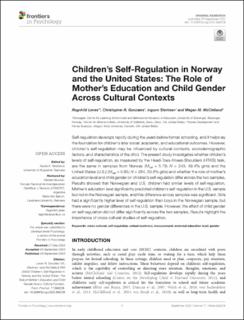| dc.contributor.author | Lenes, Ragnhild | |
| dc.contributor.author | Christopher R, Gonzales | |
| dc.contributor.author | Størksen, Ingunn | |
| dc.contributor.author | McClelland, Megan | |
| dc.coverage.spatial | Norway and USA | en_US |
| dc.date.accessioned | 2021-01-21T09:49:06Z | |
| dc.date.available | 2021-01-21T09:49:06Z | |
| dc.date.created | 2020-09-24T10:31:11Z | |
| dc.date.issued | 2020-09 | |
| dc.identifier.citation | : Lenes R, Gonzales CR, Størksen I and McClelland MM (2020) Children’s Self-Regulation in Norway and the United States: The Role of Mother’s Education and Child Gender Across Cultural Contexts. Front. Psychol. 11:566208. doi: 10.3389/fpsyg.2020.566208 | en_US |
| dc.identifier.issn | 1664-1078 | |
| dc.identifier.uri | https://hdl.handle.net/11250/2724065 | |
| dc.description.abstract | Self-regulation develops rapidly during the years before formal schooling, and it helps lay the foundation for children’s later social, academic, and educational outcomes. However, children’s self-regulation may be influenced by cultural contexts, sociodemographic factors, and characteristics of the child. The present study investigates whether children’s levels of self-regulation, as measured by the Head-Toes-Knees-Shoulders (HTKS) task, are the same in samples from Norway (Mage = 5.79; N = 243, 49.4% girls) and the United States (U.S.) (Mage = 5.65; N = 264, 50.8% girls) and whether the role of mother’s education level and child gender on children’s self-regulation differ across the two samples. Results showed that Norwegian and U.S. children had similar levels of self-regulation. Mother’s education level significantly predicted children’s self-regulation in the U.S. sample but not in the Norwegian sample, and this difference across samples was significant. Girls had a significantly higher level of self-regulation than boys in the Norwegian sample, but there were no gender differences in the U.S. sample. However, the effect of child gender on self-regulation did not differ significantly across the two samples. Results highlight the importance of cross-cultural studies of self-regulation. | en_US |
| dc.language.iso | eng | en_US |
| dc.publisher | Frontiers Media S.A | en_US |
| dc.rights | Navngivelse 4.0 Internasjonal | * |
| dc.rights.uri | http://creativecommons.org/licenses/by/4.0/deed.no | * |
| dc.subject | barns selvregulering | en_US |
| dc.subject | kjønnsroller | en_US |
| dc.subject | tverrkulturelle studier | en_US |
| dc.title | Children`s Self-regulation in Norway and the United States: The Role of Mother`s education and Child Gender across Cultural Contexts | en_US |
| dc.type | Peer reviewed | en_US |
| dc.type | Journal article | en_US |
| dc.description.version | publishedVersion | en_US |
| dc.rights.holder | Copyright © 2020 Lenes, Gonzales, Størksen and McClelland. | en_US |
| dc.subject.nsi | VDP::Samfunnsvitenskap: 200::Psykologi: 260 | en_US |
| dc.subject.nsi | VDP::Samfunnsvitenskap: 200::Pedagogiske fag: 280 | en_US |
| dc.source.journal | Frontiers in Psychology | en_US |
| dc.identifier.doi | 10.3389/fpsyg.2020.566208 | |
| dc.identifier.cristin | 1832880 | |
| dc.relation.project | Norges forskningsråd: 237973 | en_US |
| dc.relation.project | Norges forskningsråd: 270703 | en_US |
| dc.relation.project | Norges forskningsråd: 275576 | en_US |
| cristin.ispublished | true | |
| cristin.fulltext | original | |
| cristin.qualitycode | 2 | |

